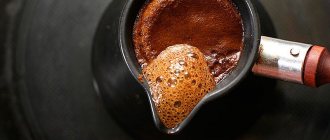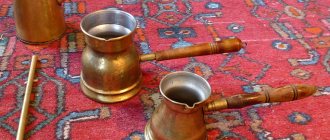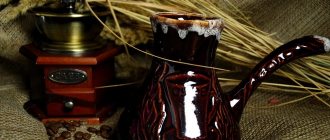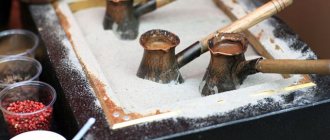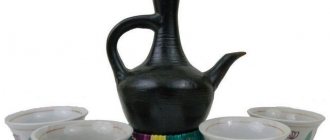World-famous Turkish coffee is served in small cups, and it is always decorated with a layer of thick, dense golden-brown foam. The ingredients of the drink and the recipe are very simple, but it is not always possible to achieve the same foam and the desired quality on your own. We'll tell you all about how to brew Turkish coffee with foam, what could be the reasons for failure, and how to do it right.
How to make coffee with thick foam
The foam consists of microparticles of coffee oils, carbon dioxide and a microsuspension of ground particles. Classic Turkish coffee culture uses finely ground beans, “to dust,” which also helps create a denser foam layer. With a traditional medium grind you can also get a head of foam, but it's a little more difficult and it definitely won't be as high and dense.
To prepare Turkish coffee with foam, it is important not to bring it to a boil, otherwise all the bubbles will quickly disappear (or the drink will run away).
How is coffee foam formed?
Foam owes its origin to two things:
The essence of the grinding process includes not only grinding the coffee beans, but also enriching them with oxygen. Oxygen occupies all the free space between the coffee grains and, along with them, enters the Turk.
When heated, the air rushes upward and lingers on small grains of coffee that float on the surface of the water. They hold him and do not allow the Turk to leave. If the grind is coarse, then all the coffee will be at the bottom and will not be able to retain oxygen.
What you need to brew Turkish coffee correctly, with foam
Follow the recommendations and detailed instructions, and you will succeed. It is important to maintain proportions and use suitable containers and ingredients.
We will need:
Turk
Turka, cezva or ibrik, is a traditional vessel for brewing an oriental drink. It is distinguished by a fairly wide bottom and a relatively narrow or at least simply tapering neck. You can try it in a small ladle, but the narrower it is on top, the better. In other words, if the ladle is taller than wide, you will not make foamy coffee at the bottom of a large pot.
Important: it is advisable to take a Turk of such a volume that there is just enough to pour into a cup or cups. The liquid should be up to the neck. In a 400 ml Turk, it will be almost impossible to brew a 100 ml portion of the drink so that foam forms.
“To the neck” does not mean “to the edge.” The foam needs somewhere to rise, and since it happens quickly, you can be distracted for a second, and it will already run away. If you are preparing a sweet drink, add sugar immediately to the cuzurka. Keep in mind that it also takes up some volume, so first pour in all the ingredients, and then pour in water, leaving some space for the foam to grow.
Finely ground coffee
Standardly, ground coffee in packs is ground to a medium degree. This grind is suitable for coffee makers, brewing in a geyser, filter, or just in a cup. Yes, and in a Turk it is quite possible to make a good drink from it, and even the foam can rise and run away. The only problem is that these particles are quite large, and if you do not wait for them to completely settle or filter out, they are unpleasant to drink (and it can also cause heartburn).
For traditional coffee in Turkey, the finest grind is used, and these particles participate in the formation of a foamy layer on the surface. You can ask to grind the beans this way when buying in a store or look for coffee made in Turkey (most often it comes in soft packs). Home coffee grinders are different, but not all of them are capable of producing such a fine grind, so it is better to first buy a real Turkish product, and then compare what you get from coffee grinders with it.
Important: for preparation, use approximately 1 tablespoon of ground coffee beans per serving.
As for a specific variety or mixture, it can be 100% Arabica or its mixture with Robusta. In eastern countries, Arabica is mainly used for its taste and aromatic qualities, but Robusta itself produces a denser and more bitter foam, so you can choose mixtures.
It is not worth cooking exclusively from Robusta for the sake of obtaining foam; the taste and aroma will be poor and bitter.
Water
To make a truly tasty drink, you need high-quality water. Preferably purified or filtered, and always cold. You should not pour hot or even warm water into the Turk to speed up the process. If the water is at room temperature, you can add an ice cube to cool it further.
Sugar and spices
Stirring additional ingredients into the cup will destroy the foam layer. Therefore, everything that is needed is added to the cezve and then brewed. Adding even the smallest amount of sugar increases your chances of getting a denser foam, so you can add just a little so that it won't be felt in the drink. However, you can do without it.
Milk
This ingredient is generally quite questionable in a classic drink. In Turkey, they may even refuse to serve you milk separately, as they believe that it spoils the traditional taste. But if you prefer milk and coffee cocktails, pour it over the side so as not to destroy the foam, or immediately pour in the milk, and then the contents of the cezve. The main thing is not to stir with a spoon.
Preparation
Three ingredients
To prepare a delicious drink at home, prepare a Turk, ground grains and water. Each component is important, so choose based on your own tastes and needs.
The heating element does not play a special role: Turkish coffee on a gas stove turns out no worse than on sand or an electric burner.
Choosing a cezve
The shape of the container for brewing coffee should be conical, with a noticeable expansion of the bottom. This type of Turk will not allow sediment to rise along with the foam, so the liquid will be obtained with a minimum amount of impurities.
The top of the cezve is also important - the thinner the neck, the denser the foam. Copper is considered the best material for Turks, as it has good thermal conductivity (401 W/(m K)).
Continuing the topic, we recommend that you read the article “How to choose a Turkish coffee pot.”
Selecting grains
The grains must be of high quality, with a shiny, even texture, free of foreign odors and impurities of sand and insects. It is better to buy them in specialized stores and in their entirety.
Grind the grains into powder. The finer the grind, the denser the cream and the richer the infusion. But not to the point of dust, otherwise there will be a lot of sediment in the finished coffee.
Interesting! Methods for brewing coffee in a Turk on the stove, the best recipes and basic rules
If it is not possible to grind the grains before cooking, buy fresh grinding, in small quantities. Stale powder loses its odor and fat content. If stored improperly, ground grains may go rancid.
The article “How to store coffee beans at home” will help you avoid this.
The variety depends on preference. Some choose elite Arabica, others choose strong Robusta, while others choose a mixed version.
What should the water be like?
High-quality water is the key to a pleasant, rich taste and aroma of the drink.
According to coffee connoisseurs, the best option is well or spring clear liquid.
Experts say that using filtered tap water you can get expressive coffee with dense foam. This is due to minerals (calcium, magnesium, potassium) and salts in the water.
In urban conditions, when preparing an invigorating drink, it is better to take soft bottled water.
Don't use distilled water. The coffee will be watery and weak.
How to brew coffee with foam in a Turk: recipe
So, we have decided on the ingredients and the necessary utensils. Let's prepare a “standard” portion:
- Finely ground coffee – a small heaped tablespoon;
- Water – about 90–100 ml;
- Sugar, if you like;
- Spices - cardamom, star anise, cinnamon, cloves, nutmeg - all in ground form.
Now - in detail about cooking:
- Pour all the dry ingredients into the cezve.
- Fill with cold water. You can measure the exact amount into a cup and pour it into the cezve.
- Stir.
- Place on low heat.
- Don't go far! After a while, dark foam will begin to rise. When this happens, remove the cezve from the heat and let the foam head fall.
- Place it on the fire again (you can hold it by the handle over the fire, rather than standing it down), and remove it again for a while.
- Make the foam layer rise a third time and remove from heat completely.
- If this is one serving, pour the entire contents into a cup, making sure that all the foam is poured out. If there are several servings, try transferring the foam into cups with a spoon, and then pour the drink itself over the wall.
How to brew Turkish coffee with foam for people with different sugar preferences
This is quite an interesting point. We then do not add sugar or stir it, but according to tradition, foam must be present, this is an indicator of the quality of preparation. Use the hint:
- Prepare an unsweetened drink with foam raised three times and pour the foam into cups.
- Serve sugar-free servings for those who don't need sweetness.
- Put the sugar in the cezve with the remaining liquid and stir, there is still no foam there, pour it sweeter for those who like it.
- We remind you that you need to pour the drink carefully, along the wall, so as not to break the foam layer.
Why coffee with foam may not work in Turkish
Sometimes this happens for a variety of reasons, especially among beginners, and here are the most common reasons:
Old coffee
Microbubbles are formed, among other things, due to the release of carbon dioxide, which accumulates in the beans during roasting. Manufacturers usually vacuum seal the ground product well, but if you store it at home in an open package or in a jar that is too large, it will dissipate. Try a fresher roast, maybe that's what it's all about.
Boiling
Boiling kills microbubbles by breaking them into larger ones that burst from the bottom, so be careful not to overheat the drink. For brewing, the first bubbles that rise from the bottom are enough, that is, the very beginning of the appearance of foam (especially, we do this three times, for greater density). Carefully monitor the condition of the liquid and do not let it boil.
Unsuitable cookware
You need a sufficient layer of grounds and suspension to form foam while the entire layer of liquid is heated and has not yet reached a boil. This is why Turks with a narrow neck are so good, and why it is worth taking dishes of a suitable size. If the portion splatters on the wide bottom, it will boil rather than foam.
The nuances of choosing a Turk for making coffee
A turka, or, as it is otherwise called, a cezve, is a vessel made of a metal alloy, the neck of which is narrowed, and for more comfortable holding there is a long wooden handle.
Such utensils have been used since ancient times and are considered the best equipment for brewing coffee. There are a large number of special coffee machines in the modern world, but they are much inferior to the classic version.
The wide bottom allows you to heat the contents of the cezve evenly, and the narrowed neck cools the grounds. The long handle helps you avoid getting burned when using it. Volume may vary. In this case, one serving cup accounts for approximately 65-70 mm. The volume of the turk directly affects the taste and quality of the prepared coffee. Therefore, it is better to choose dishes with a smaller capacity, designed for 1-2 servings.
Coffee brewed on the stove is a truly unique drink. Therefore, before buying a Turk, you need to familiarize yourself with the rules for choosing it.
Depending on the material from which the Turk is made, ceramic, clay and copper products are distinguished. Each species has its own specific characteristics.
- Clay Turks. The disadvantages of the product include the fact that its walls quickly absorb the aroma, which does not disappear afterwards. Therefore, it is recommended to choose only one type of coffee for such cezves. Otherwise, the smells will mix and the pleasant drink will no longer delight you with its invigorating aroma.
- Ceramic Turks. Nowadays, such Turks are rarely used and can not often be found in stores. This is due to their fragility and fragility. But if such a variation is available at home, it is better to give preference to it.
- Aluminum Turks. This species is quite widespread compared to others. It is characterized by high thermal conductivity, strength and low cost. However, experts do not recommend using this particular type of jazz, since the material is not stable and tends to react with the contents. This can negatively affect the condition of the body.
- Copper Turks. The most preferred option. Such dishes have thick walls, which ensure uniform and complete heating of the contents.
You can also find silver and gold-plated Turks on store shelves. However, they are not recommended for use, as they serve more of a decorative function.
How to brew Turkish coffee with foam using video
Youtube is full of videos of the process of making coffee with a head of brown foam. The basic principle is clear for any of them, except that some wait until the foam rises once, others do it three times, there are those who pour coffee on top of the water and do not stir, and there are adherents of the traditional recipe with stirring. This is not all that important if the result suits you.
Try to cook according to the video with the proportions, dishes, stove, and grinding as similar as possible to yours. This will make it easier to repeat the result.
How to Serve and Drink Coffee with Foam
You learned how to brew coffee in a Turk with foam so that it is high and dense. But you also need to present this drink aesthetically and correctly. Traditionally it is poured into small demitasse cups, Turkish coffee cups. The portions are small, as the drink is quite strong. The grounds are not strained, but poured into a cup, letting it sit for a minute until it sinks.
The drink is served with a glass of cold still water, which is drunk before coffee to cleanse the receptors and refresh the oral cavity. Turkish delight or other Turkish sweets would also be a good addition.
